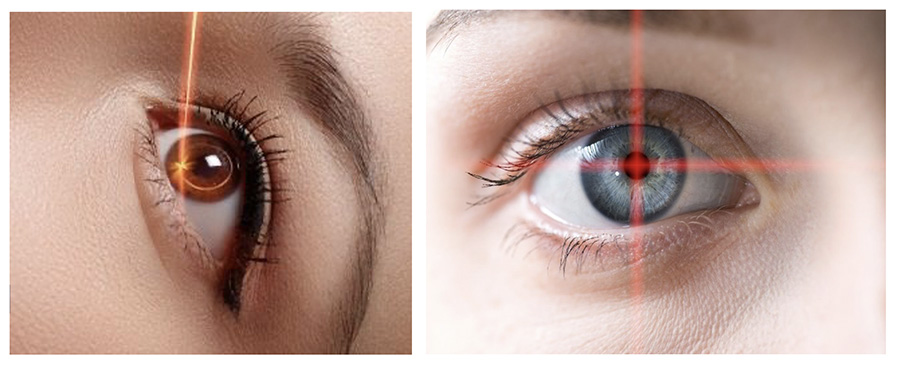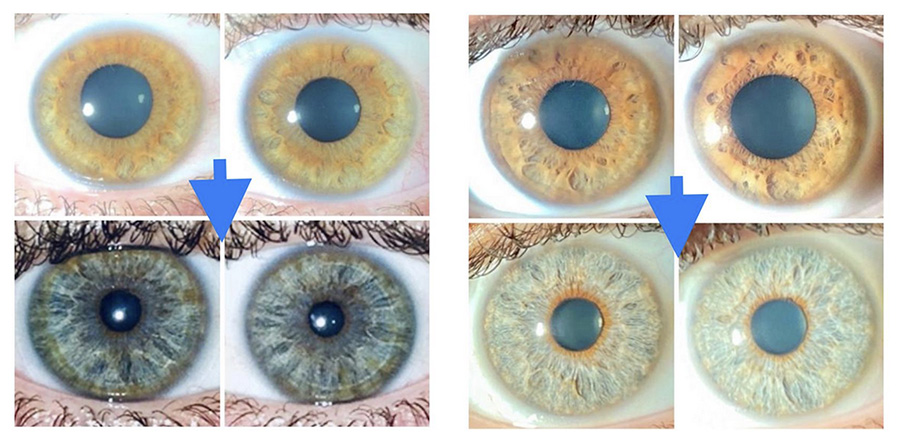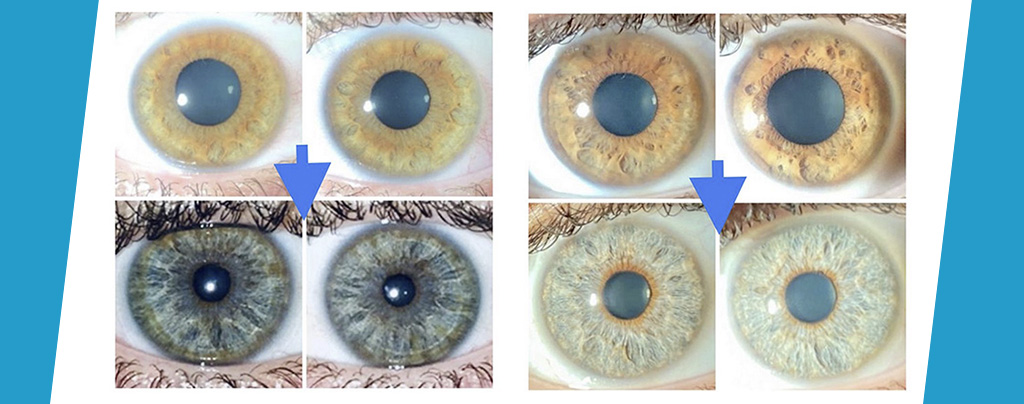Achieving a change in eye color is an aesthetic goal desired by many people, which is why, up to now, the use of contact lenses to achieve it temporarily is quite common. However, in recent years several unconventional surgical techniques have emerged without sufficient scientific evidence that offer the possibility of permanently changing eye color, and one of them is “Keratopigmentation”.
What determines the color of the eyes?
First of all, it must be taken into account that eye color is a genetic trait that is determined by the amount and distribution of melanin in the iris (colored tissue found in the front part of the eye and whose central opening is the pupil). In other words, what will determine whether certain eyes are darker or lighter than others are the amount of pigment (melanin) that each person has in the iris.
Thus, people with a greater amount of melanin in the front layers of the iris have eyes between brown and black, and, conversely, the less amount of said pigment there is, the lighter the color of the eyes: blue, green or honey color.
However, recent research has shown that this is a more complex issue related to the action of the genes involved in the iris coloring process, and although the level of incidence of each one is not known exactly, various scientists have managed to identify at least two of the most influential: the OCA2 gene, which produces a protein called P, and the HER2 gene, which is located on chromosome 15.
Can you change the color of the eyes?
Over the years, various surgical techniques to change the pigmentation of patients’ eyes have become increasingly popular, one of which has attracted much attention is annular keratopigmentation.
This surgical method consists of changing the color of the eyes by means of a laser, making a small incision in the eyeball to create a sheet in the corneal tissue, a sheet that is filled with the pigments or dyes that each patient wishes.

- Application in pathological eyes
Until now, this procedure has been used in pathological eyes to improve the cosmetic appearance of patients with pathologies that have affected their appearance. Therefore, it is mainly used to correct a wide variety of functional problems of the cornea, including:
- Abnormal ocular appearance due to injuries, diseases, or irregularities in the shape of the cornea, opacity, or corneal scarring.
- Loss of pigmentation in the cornea, such as leucoma or albinism.
- Other techniques
Ophthalmological centers in Europe have developed a laser that manages to lighten the chromaticism of human eyes permanently, going from brown to some shade of blue or green (depending on the genetics and level of pigmentation of the person).

However, it is important to emphasize that not all people are suitable candidates for these treatments, nor should they be thought of as techniques for purely aesthetic purposes, therefore, it is important that a specialist ophthalmologist determine whether or not intervention is advisable, and if it is, the type of pigmentation most appropriate for each specific patient.
What are the risks of the eye color change operation?
It is an irreversible surgical intervention, and as such it has risks. For this reason, most ophthalmology professionals are very reticent about performing color change techniques in healthy eyes, also, as it is a technique that lacks Sufficient scientific evidence to know the effect of pigments in the long term, is not authorized or endorsed by the different Academies and Societies of Ophthalmology at a global level.
Now, since this is a procedure that involves injecting ink into the cornea of the eye, it is clear that one of the main dangers is eye infection, which can lead to pain, swelling, blurred vision, and even permanent loss of vision.
In addition, it can trigger other eye diseases such as:
- Chronic dry eye
- Corneal ectasia, where it significantly loses its normal thickness.
- Photophobia or sensitivity to light.
- Allergic reactions.
- Cataracts.
- Obstruction of aqueous humor drainage.
- Glaucoma.
- Uveitis.
- Loss of transparency of the cornea.
- Loss of vision.
- Blindness.
Do these operations have sufficient security guarantees?
At present, and in accordance with the indications of different World Academies of Ophthalmology, there is not enough scientific evidence that recommend keratopigmentation to change eye color permanently, especially in the case of patients with healthy eyes, since its Use is only accepted to improve the aesthetic appearance of patients with pathological eyes such as scars or opacities. For this reason, our specialist ophthalmologists indicate that they do not believe everything that is seen on social networks about this treatment, and even more so, that it is not performed for aesthetic purposes.
“There is not enough scientific evidence to support the safety and efficacy of this intervention, as well as the consequences it causes in the long term,” says one of the ophthalmologist specialists at Clínica Sancho.
In addition, the widespread use of keratopigmentation in healthy eyes, solely for the aesthetic purpose of changing eye color, could hinder future cataract or retinal surgery that, over the years, the patient may need, since , what the laser does is depigment the iris, this pigment will occlude the trabécula and as a result a pigmentary glaucoma is caused, for this reason, the procedure has not been popularized in English-speaking countries such as the US, nor in states more rigorous Europeans such as the United Kingdom and Germany (Dr. Byron Sancho;2023).
In the same way, as it is a method that has undergone more than 15 years of experimentation, conclusive clinical studies are still needed to confirm the efficacy and safety of this technique in healthy eyes before considering its use, due to the risks it would bring to the eyes. patients with healthy eyes, would be irreversible, in addition “the testimonials that have been issued in favor of this technique, are pronounced mainly by the few doctors who have performed the treatment, all this in order to offer their aesthetic centers, selling a false security and reserving the side effects that it will bring in the long term, a clear example of this is that by destroying the pigment, the patient is immediately being induced to suffer from severe photosensitivity or other irritations” (Dra. Ligia Sancho;2023).
In any case, if you want a change in eye color, you can resort to the use of colored contact lenses, which are a safe and effective technique, and an example of this are cosmetic prosthetic contact lenses of various colors, the which allow patients to have a more natural tonality, not so much artificial.
“These cosmoprosthetic lenses are used for patients who require a color change or want a different expression such as blue, green, gray, etc., and their advantage is that they are annual lenses and exist in the Clínica Sancho laboratory (MILAB)”, pointed out our specialist in contactology Byron José Sancho.

Thus, we conclude that it is necessary to wait for unquestionable clinical studies to confirm the efficacy and safety of this technique before implementing it in patients with healthy eyes.
Bibliographic references:
-
(1 de Julio de 2021). Neweyes Laser 7G Ultimate Custom Laser. Obtenido de Eyecos Web site: https://eyecos.eu/neweyes-laser-7g/
-
Ferrari, F. (05 de Agosto de 2013). El método quirúrgico presentado en este sitio web es el desarrollado por el doctor Francis Ferrari, pionero y líder en el cambio del color de los ojos mediante queratopigmentación. Obtenido de Neoris Web site: https://neoris-eyes.com/es/queratopigmentacion-metodo/
-
Gómez, N. (16 de Septiembre de 2020). ¿Qué determina el color de los ojos? Obtenido de El Español Web site: https://www.elespanol.com/curiosidades/cuerpo-humano/factores-color-ojos-determina-porque-verdes-azules-marrones-negros-bicolor-bebes/520948827_0.amp.html
-
Instituto Nacional del Cáncer. (06 de Enero de 2020). gen OCA2. Obtenido de Diccionario del NCI Web site: https://www.cancer.gov/espanol/publicaciones/diccionarios/diccionario-cancer/def/gen-oca2
-
Instituto Nacional del Cáncer. (06 de Enero de 2020). HER2/neu. Obtenido de Diccionarios del NCI Web site: https://www.cancer.gov/espanol/publicaciones/diccionarios/diccionario-cancer/def/her2-neu
-
Muñoz, G. (14 de Marzo de 2023). Cambio de color de ojos: ¿en qué consiste la operación? Obtenido de Clínica Baviera Web site: https://www.clinicabaviera.com/blog/cambio-de-color-de-los-ojos-operacion/
-
Perera, D. (19 de Abril de 2023). Peligros del cambio de color de ojos. Obtenido de Daniel Perera Centro Oftalmológico Web site: https://centrooftalmologicoperera.com/los-peligros-del-cambio-de-color-de-ojos-con-la-queratopigmentacion/
-
Sancho, Byron. (15 de Mayo de 2023). Queratopigmentación. (A. C. A., Entrevistador)
-
Sancho, Byron José. (18 de Mayo de 2023). Lentes de contacto cosmoprotésicos. (A. C. A., Entrevistador)
-
Sancho, Christian. (22 de Mayo de 2023). Queratopigmentación. (A. C. A., Entrevistador)
-
Sancho, Ligia. (24 de Mayo de 2023). Queratopigmentación. (A. C. A., Entrevistador)
-
Vista Sánchez Trancón Oftalmólogos. (10 de Febrero de 2022). ¿Es posible cambiar el color de los ojos? 10 posibles causas. Obtenido de Vista Oftalmólogos Web site: https://vistasancheztrancon.com/cambiar-color-de-ojos/

